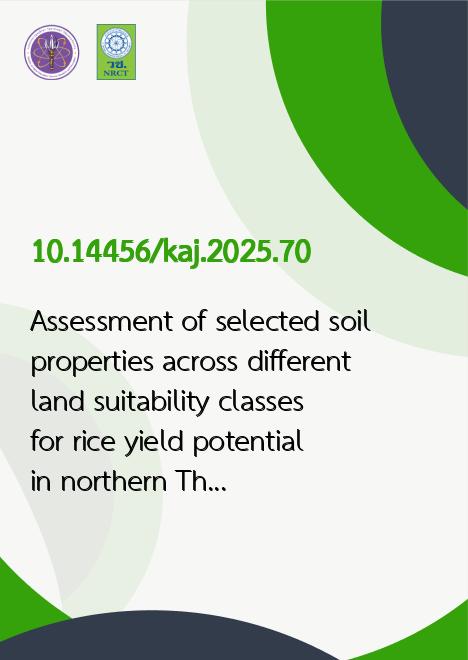
|
Assessment of selected soil properties across different land suitability classes for rice yield potential in northern Thailand |
|---|---|
| รหัสดีโอไอ | |
| Creator | Nednapa Insalud |
| Title | Assessment of selected soil properties across different land suitability classes for rice yield potential in northern Thailand |
| Contributor | Pitchanan Kanghae, Suttakan Jaikawin, Vassana Viroonrat, Sutheera Hermhuk |
| Publisher | Faculty of Agriculture |
| Publication Year | 2568 |
| Journal Title | Khon Kaen Agriculture Journal |
| Journal Vol. | 53 |
| Journal No. | 5 |
| Page no. | 1002-1018 |
| Keyword | rice production potential, soil properties, rice (Oryza sativa L.), North of Thailand |
| URL Website | https://li01.tci-thaijo.org/index.php/agkasetkaj |
| Website title | Khon Kaen Agriculture Journal |
| ISSN | 3027-6497 (Online) |
| Abstract | Rice yield in northern Thailand remains relatively low despite being supported by agricultural zoning policies that aim to promote land use based on the potential of each area. Continuous rice cultivation without proper soil management has led to soil property limitations that affect rice production potential. This study aimed to assess rice production potential in areas classified as highly suitable (S1) and moderately suitable (S2) across eight provinces in northern Thailand. Key soil properties were analyzed, rice yields were compared by variety and soil texture, and preliminary correlations between soil properties and rice yield were explored. Data were collected from 318 paddy fields during the 2021 wet season. The results showed that the majority of soil types were sandy loam, which is coarse-textured and inherently low in fertility. Available phosphorus ranged from low to moderately low, exchangeable potassium was at moderate to low levels, and soil pH ranged from strongly to moderately acidic. A discrepancy was found between actual soil properties and their assigned land suitability classes. While S1 areas showed high potential for rice production, some fields still yielded poorly. Conversely, S2 areas had moderate average yields but a higher proportion of low- and very low-yielding fields. The rice variety Sanpatong 1 yielded the highest in S1 areas, while RD6 and KDML105 performed better in S2 areas. These findings suggest that enhancing rice productivity requires field-level soil sampling and chemical analysis to enable site-specific fertilizer management. Moreover, integrating macro-scale land suitability maps with field-based data will support more precise and sustainable land management for rice production. |